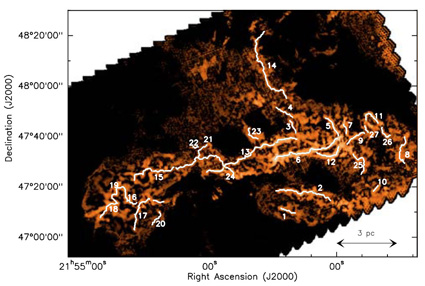Here's some quotes from mainstream websites:
from:Astronomers using the Atacama Large Millimeter/submillimeter Array (ALMA)
have discovered that two young stars forming from the same swirling protoplanetary disk may be twins — in the sense that they came from the same parent cloud of star-forming material. Beyond that, however, they have shockingly little in common.
"The main, central star of this system, which is located approximately 11,000 light-years from Earth, is truly colossal — a full 40 times more massive than the Sun. The other star, which ALMA recently discovered just beyond the central star’s disk, is a relatively puny one-eightieth (1/80) that mass.
Their striking difference in size suggests that they formed by following two very different paths. The more massive star took the more traditional route by collapsing under gravity out of a dense “core” of gas. The smaller one likely followed the road less traveled by – at least for stars – by accumulating mass from a portion of the disk that “fragmented” away as it matured, a process that may have more in common with the birth of gas-giant planets.
“Astronomers have known for a long time that most massive stars orbit one or more other stars as partners in a compact system, but how they got there has been a topic of conjecture,” said Crystal Brogan, an astronomer with the National Radio Astronomy Observatory (NRAO) in Charlottesville, Virginia, and a co-author on the study. “With ALMA, we now have evidence that the disk of gas and dust that encompasses and feeds a growing massive star also produces fragments at early stages that can form a secondary star.”"
https://public.nrao.edu/news/2018-alma- ... ting-disk/
"
from:Their new clues support the idea that double-star systems form when a disk of gas and dust whirling around one young star fragments, forming another new star in orbit with the first. Young stars that still are gathering matter from their surroundings form such disks, along with jet-like outflows rapidly propelling material in narrow beams perpendicular to the disk.
When Tobin and an international team of astronomers studied gas-enshrouded young stars roughly 1,000 light-years from Earth, they found that two had previously-unseen companions in the plane where their disks would be expected, perpendicular to the direction of the outflows from the systems. One of the systems also clearly had a disk surrounding both young stars.
“This fits the theoretical model of companions forming from fragmentation in the disk,” Tobin said. “This configuration would not be required by alternative explanations,” he added."
https://scitechdaily.com/new-research-b ... on-theory/
from:To shed light on the peculiar pair, the researchers used the Atacama Large Millimetre/submillimetre Array (ALMA) to probe the star system — observing the light frequencies that emit from the disk’s gas and measuring the radiation that emits from the disk’s dust. They used this information to calculate the mass of the stars, and found that MM 1a is about 40 times the mass of our Sun, and that MM 1b weighs just half our Sun’s mass.
To account for this stark contrast, the researchers think that MM 1b was actually born in a fragment of MM 1a’s disk. Due to its hefty mass, they believe that the disk wasn’t able to hold up against its own gravity, and ended up breaking off into fragments. One of those fragments housed enough dust and gas to create the low mass companion star, and possibly a planet-forming disk of its own.
http://www.astronomy.com/news/2018/12/p ... on-instead
It appears that the boldfaced by myself is what all of these theories have in common: a 'fragmentation' or 'separating' of the disc from another and mass accretion. I wonder what they think of the birkeland filaments that house these stars? I haven't found a single report about how those dynamics would work out with star formation, especially the newly theorized binary star formation.
What does the EU/PC propose about binary star formation? I think its nearly as ignorant as modern astrophysics and astronomy!


